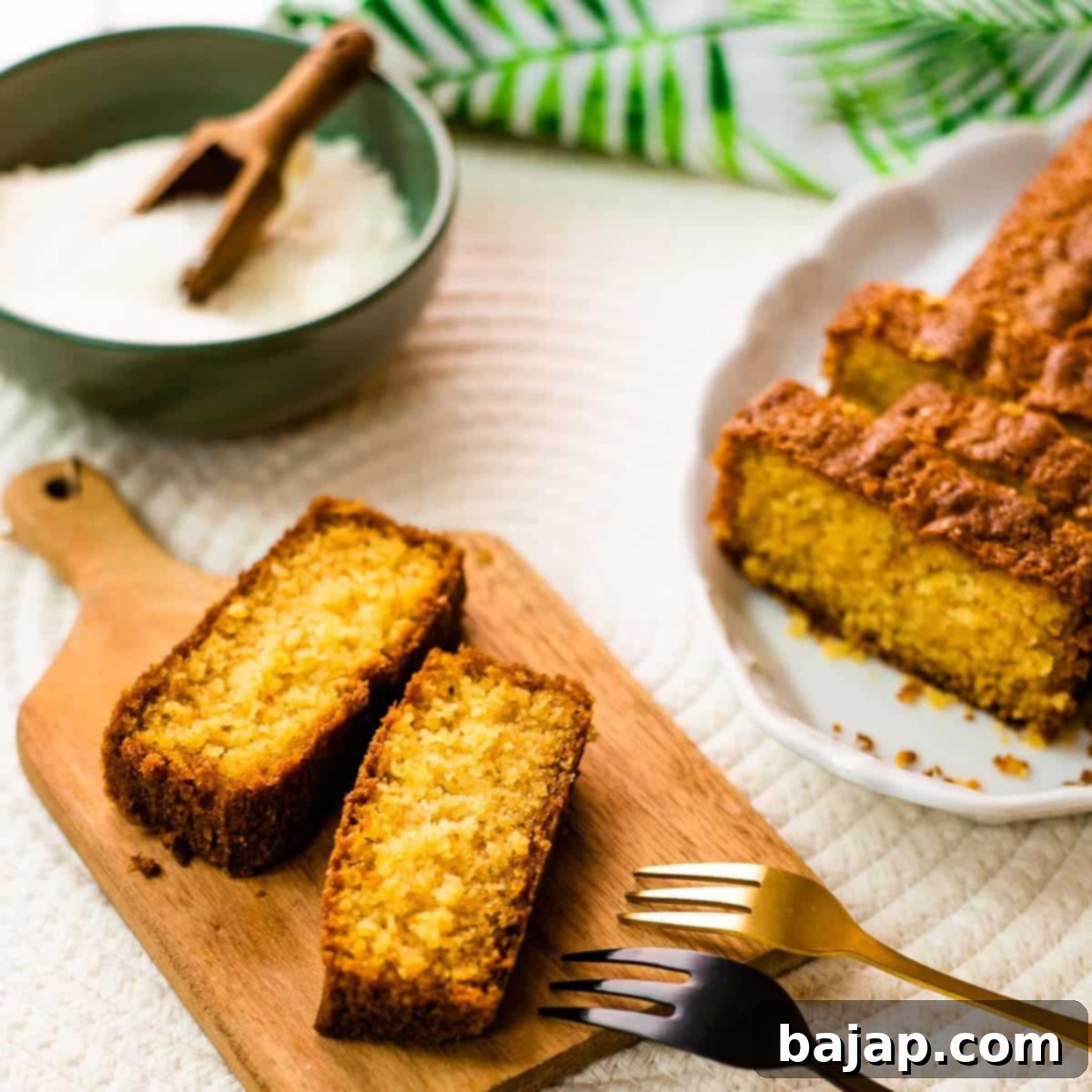The Ultimate Moist and Buttery Coconut Pound Cake Recipe for Any Occasion
This Coconut Pound Cake Tastes Like a Summer Vacation – and it’s easier to make than you think!
Imagine a slice of pure sunshine on your plate. This easy Coconut Pound Cake is exactly that: a culinary escape to a tropical paradise. It’s incredibly buttery, wonderfully moist, and utterly bursting with the rich, aromatic flavor of shredded coconut. Whether you’re planning a delightful brunch, searching for the perfect dessert, or simply looking for a heartfelt gift, this homemade coconut pound cake recipe is your answer.
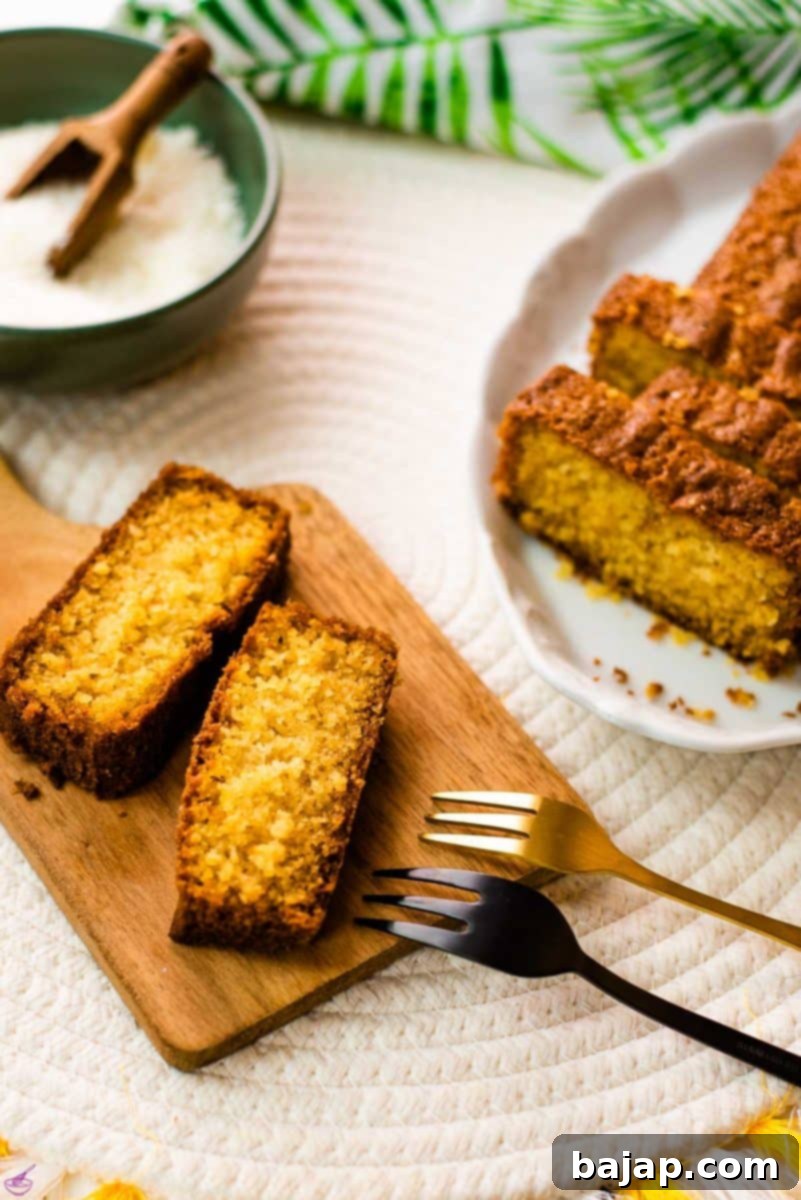
The secret to its irresistible tenderness lies in the combination of unsalted butter and coconut milk, infusing every bite with deep, tropical notes. This recipe is designed to be straightforward, using ingredients you likely already have on hand, ensuring a stress-free baking experience with spectacular results. It’s truly one of the best pound cake recipes you’ll find, especially for coconut enthusiasts!
If you’re a devoted coconut lover, don’t stop here! You’ll also want to explore my delightful Coconut Chocolate Chip Cookies for another dose of tropical goodness. For an extra indulgent treat, elevate your coconut pound cake experience by serving it with a generous scoop of Homemade Vanilla Ice Cream, or a dollop of our light and airy coconut-flavored whipped cream. The creamy coolness perfectly complements the cake’s rich texture.
Craving a soft, rich cake that tastes like pure sunshine and transports you to a blissful beach getaway? Let’s get baking and create this incredible homemade coconut pound cake!
Why You’ll Love This Easy Coconut Pound Cake Recipe
This isn’t just another cake recipe; it’s a guaranteed crowd-pleaser that brings joy with every slice. Here’s why this moist coconut pound cake will quickly become a favorite in your kitchen:
- Freezes Beautifully for Make-Ahead Baking: Planning ahead has never been easier! This coconut pound cake freezes exceptionally well, making it perfect for preparing in advance. Bake a loaf (or two!), wrap it tightly, and save it for a busy week, an impromptu gathering, or a delightful last-minute gift. It thaws perfectly, retaining all its moistness and flavor.
- Buttery and Soft with a Delicate Coconut Flavor: The texture of this pound cake is truly divine – incredibly tender and melt-in-your-mouth soft, thanks to a generous amount of butter and the moistening power of coconut milk. The coconut flavor is prominent yet perfectly balanced, offering a rich, tropical essence without being overpowering. It’s a sophisticated sweetness that appeals to all.
- Made with Everyday Ingredients You Likely Have at Home: Forget obscure specialty items! This recipe relies on common pantry staples like flour, sugar, eggs, and butter, along with shredded coconut and coconut milk. This accessibility means you can whip up this fantastic cake whenever the craving strikes, without a special trip to the grocery store.
- Perfect for Holidays, Coffee Breaks, or Gifting: Its elegant simplicity makes this coconut pound cake versatile for any occasion. Serve it as a festive holiday dessert, a comforting treat with your afternoon coffee, or slice it up and package it beautifully for a thoughtful homemade gift. Its universal appeal makes it a beloved choice for celebrations and everyday indulgences alike.
🥘 Key Ingredients for Your Moist Coconut Pound Cake
Crafting the best coconut pound cake starts with high-quality ingredients. Each component plays a vital role in achieving that perfect texture and unforgettable flavor. Here’s a closer look at what you’ll need to create this simple yet spectacular tropical dessert:
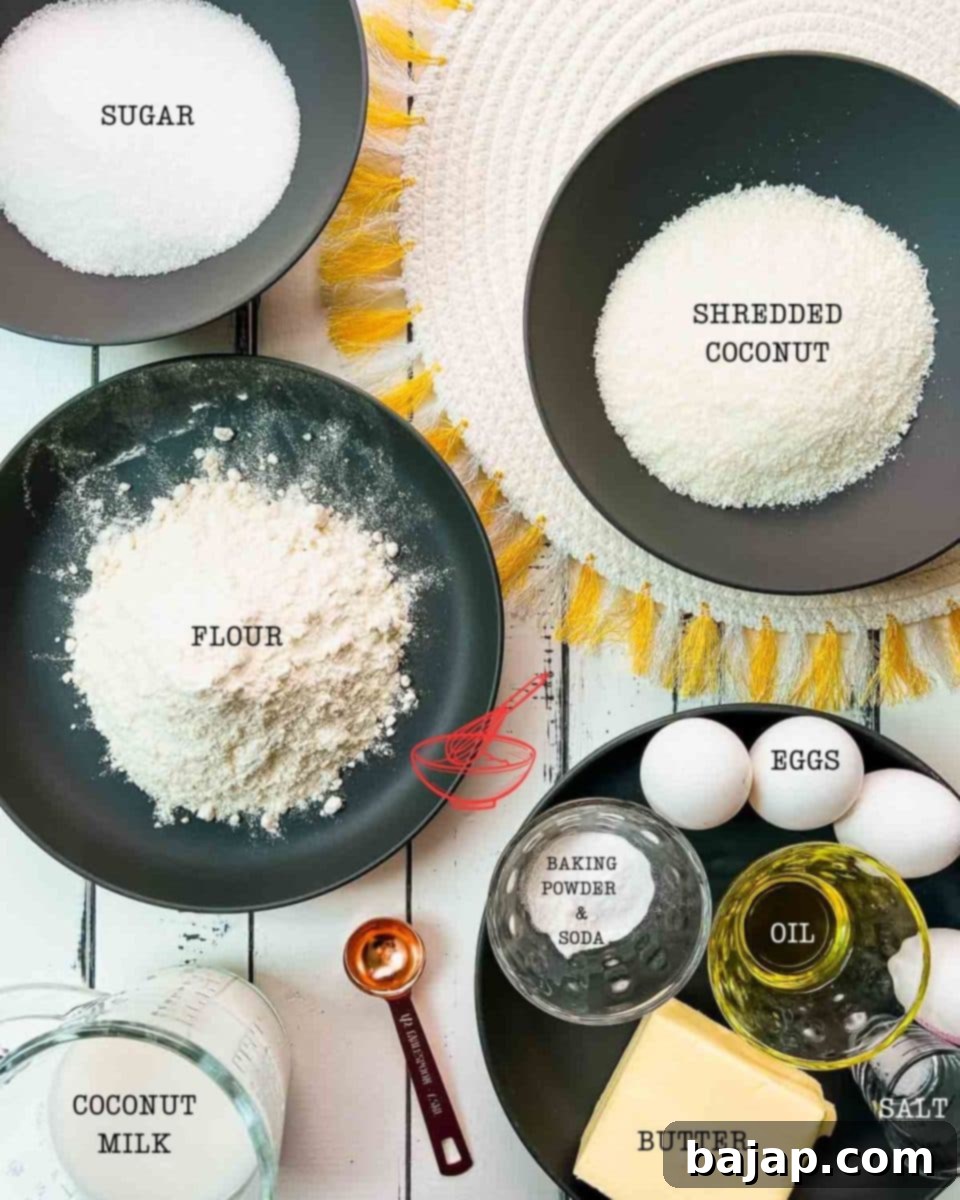
- Shredded Coconut: This is the star! Use unsweetened shredded coconut for the most authentic flavor. Soaking it in coconut milk and rum beforehand infuses the liquid with coconut essence and ensures the coconut flakes themselves become wonderfully tender and moist within the cake.
- Unsweetened Coconut Milk: Opt for full-fat canned coconut milk for the richest flavor and most luxurious texture. Its creaminess is key to the cake’s moistness. While you can substitute with whole milk, using coconut milk truly amplifies the tropical profile.
- White Rum: A touch of white rum adds a subtle warmth and enhances the coconut flavor beautifully. The alcohol bakes out, leaving behind a delightful aroma. If serving to children or prefer an alcohol-free version, simply substitute with an equal amount of coconut milk, as I did!
- Unsalted Butter: The foundation of any good pound cake! Ensure your unsalted butter is at perfect room temperature – soft enough to indent with a finger, but not melted. This allows it to cream properly with the sugar, creating a light, airy base for your batter.
- Granulated Sugar: Provides sweetness and helps create a tender crumb by interacting with the butter during the creaming process.
- Eggs: Medium-sized and at room temperature are ideal. Eggs act as a binder, provide structure, and add richness and moisture to the cake. Room temperature eggs emulsify better with the butter and sugar, leading to a smoother, more uniform batter.
- All-Purpose Flour: The primary structural component. Sifting it with the leavening agents ensures even distribution and a lighter cake.
- Baking Powder & Baking Soda: These leavening agents work together to give the cake its lift and tender texture. Baking soda reacts with acidic ingredients (like coconut milk if slightly acidic, or brown sugar if used) to create carbon dioxide, while baking powder provides consistent rise.
- Kosher Salt: A pinch of salt is crucial for balancing the sweetness and enhancing all the flavors in the cake, making the coconut truly shine.
- Vegetable Oil: A secret weapon for extra moisture! A small amount of neutral vegetable oil contributes to an incredibly tender and moist crumb that stays fresh longer.
- Vanilla Ice Cream (optional): The perfect companion! A scoop of creamy vanilla ice cream melts delicately into the warm cake, creating an irresistible dessert experience.
For exact quantities and detailed measurements, please refer to the recipe card located further down.
🔪 Step-by-Step Instructions: How to Bake the Best Coconut Pound Cake
Follow these simple steps to create a show-stopping moist and buttery coconut pound cake that will impress everyone:
Step 1 – Prep your pan and oven for success.
Before you begin mixing, preheat your oven to 350°F (175°C). This ensures the oven is at the correct temperature when your batter is ready, promoting an even rise. Generously grease a standard loaf pan (9×5 inches or approximately 25 cm) and line it with parchment paper, leaving an overhang on the sides. This thoughtful step makes removing the baked cake incredibly easy and mess-free.
Step 2 – Soak the coconut for maximum flavor.
In a small bowl, combine the shredded coconut, unsweetened coconut milk, and white rum (or extra coconut milk if omitting alcohol). Stir them together gently. Let this mixture soak for at least 15 minutes while you prepare the rest of your batter. This crucial step softens the coconut and allows it to absorb the liquids, resulting in a more tender texture and a more intense coconut flavor distributed throughout the cake.
Step 3 – Cream butter and sugar until light and fluffy.
In your stand mixer fitted with a whisk attachment (or using a hand mixer), beat the room-temperature softened butter and granulated sugar on high speed for 3-4 minutes. This process, known as creaming, incorporates air into the mixture, which is essential for a light and tender pound cake. Continue beating until the mixture is visibly pale in color and has a fluffy, airy texture. This aeration is key to the cake’s rise and delicate crumb.
Step 4 – Incorporate eggs one by one.
Reduce the mixer speed to medium. Add the eggs one at a time, beating well after each addition. It’s important to stop the mixer and scrape down the sides of the bowl between additions. This ensures all ingredients are thoroughly combined and prevents the batter from separating, contributing to a smooth, uniform texture.
Step 5 – Gently fold in the dry ingredients.
In a separate bowl, whisk together the all-purpose flour, baking powder, baking soda, and kosher salt. Sift this dry mixture directly into your wet batter. Sifting helps to remove any lumps and ensures the leavening agents are evenly distributed. Mix gently on low speed until just combined. Be careful not to overmix, as this can develop the gluten in the flour too much, leading to a tough cake.
Step 6 – Add the soaked coconut mixture to the batter.
Carefully pour the pre-soaked coconut milk mixture into the cake batter. Mix for another 3-4 minutes, starting on medium speed and gradually increasing it to ensure everything is thoroughly incorporated. Again, scrape down the sides of the bowl to catch any stray ingredients. This step ensures the coconut flavor and moisture are perfectly integrated into the entire batter.
Step 7 – Pour and bake (first stage).
Transfer the prepared batter evenly into your greased and parchment-lined loaf pan. Smooth the top with a spatula to ensure an even bake. Place the pan in your preheated oven and bake for the initial 20 minutes. This first stage allows the cake to begin setting its structure.
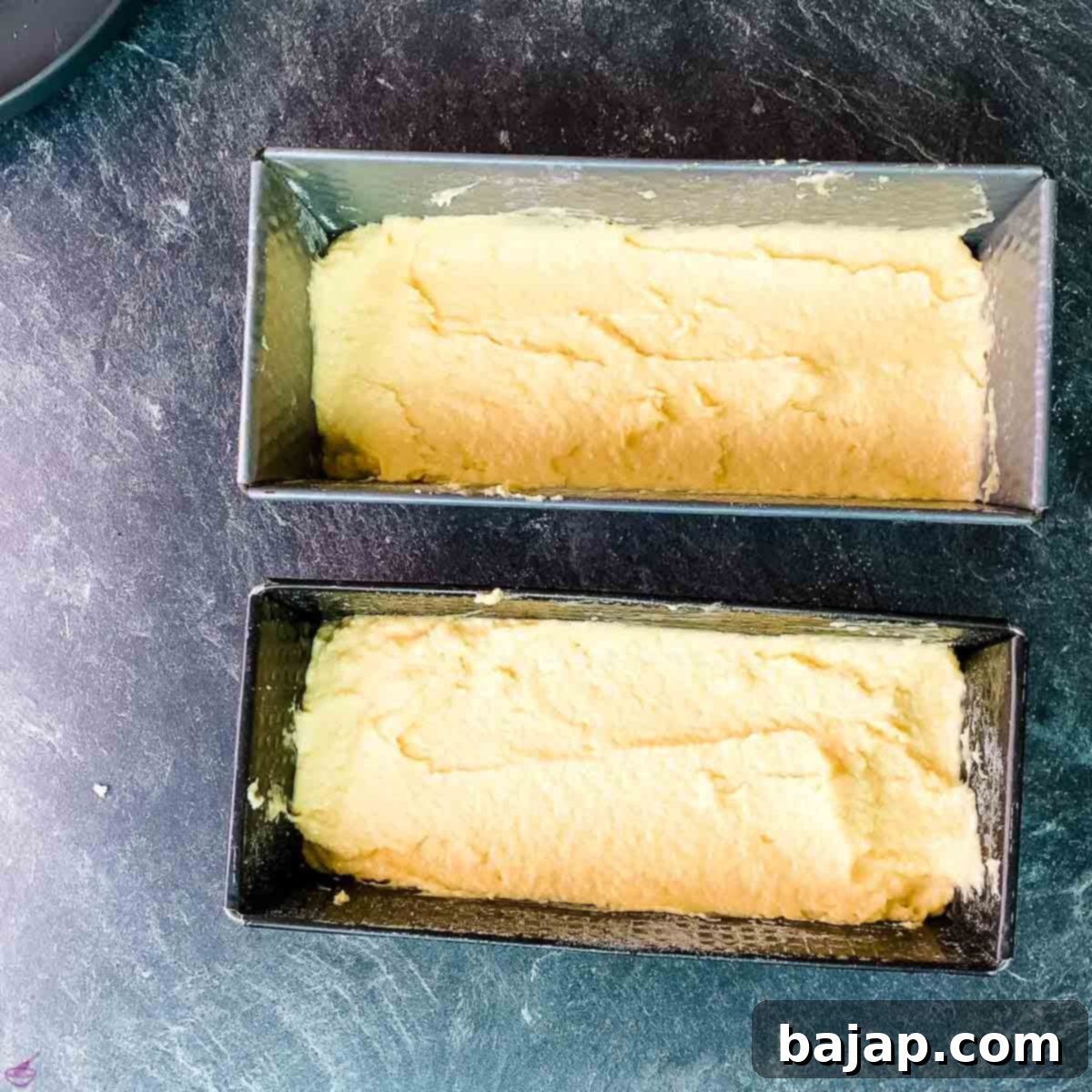
Step 8 – Score the top for an even and beautiful bake.
After the initial 20 minutes, carefully remove the cake from the oven. Using a sharp knife, gently score the top lengthwise down the center, about ½ inch deep. This scoring helps the cake bake more evenly, allowing the heat to penetrate the center, and creates that characteristic, beautiful crack on top of a classic pound cake. It’s both functional and aesthetic!
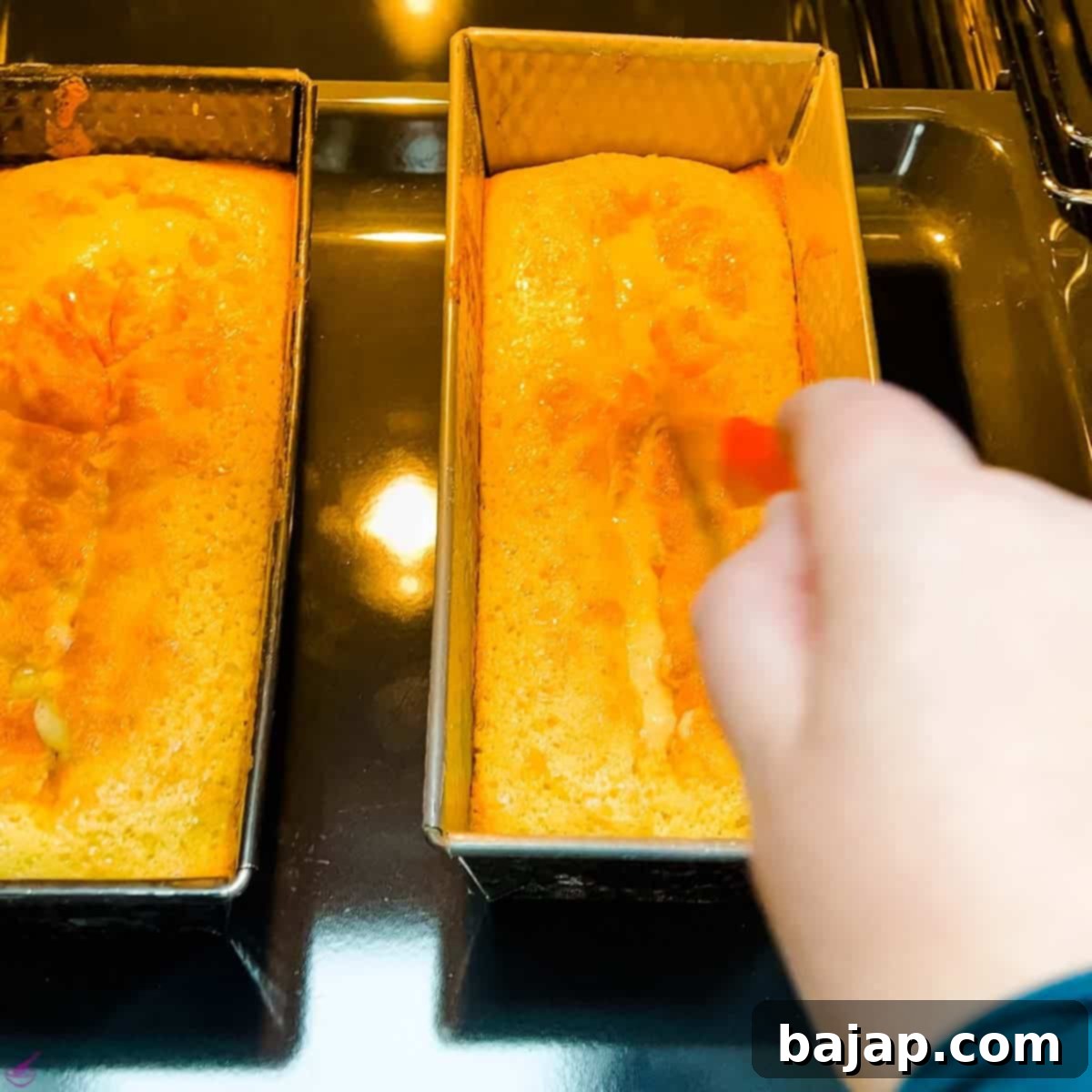
Step 9 – Finish baking and check for doneness.
Return the scored cake to the oven and continue baking for another 25 minutes, or until fully cooked. To check for doneness, insert a wooden skewer or a thin knife into the very center of the cake. If it comes out clean, without any wet batter clinging to it, your cake is ready. If not, continue baking in 5-minute increments until done.
Step 10 – Cool and serve your delicious creation.
Once baked, remove the cake from the oven. Use a spatula to gently loosen the sides of the cake from the pan, especially if you didn’t use parchment paper overhang. Allow the cake to cool completely in the pan on a wire rack before attempting to turn it out. Cooling thoroughly is essential for the cake to set properly and prevent it from crumbling. Once cool, invert the pan, remove the parchment paper, slice, and serve on its own for a simple treat, or with a generous scoop of vanilla ice cream for an ultimate dessert.
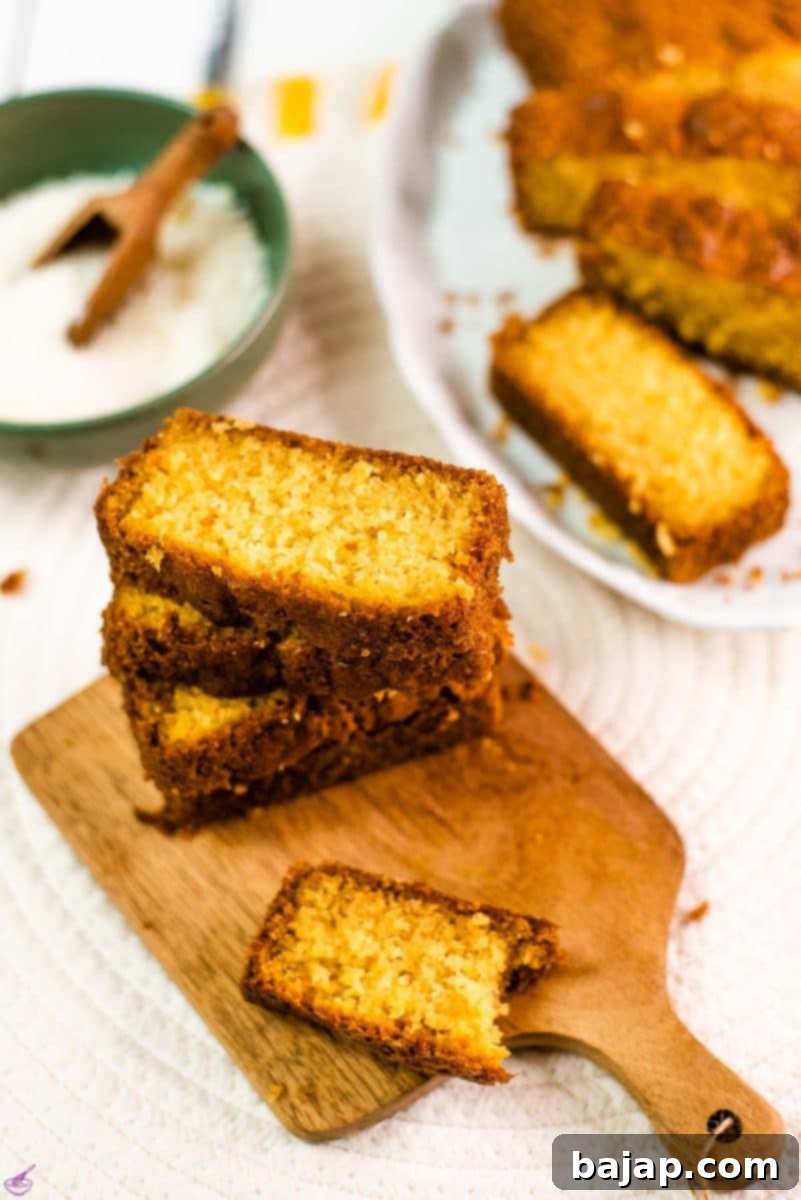
This easy coconut pound cake recipe delivers exceptional flavor and a wonderfully moist texture. It’s a fantastic addition to any menu, from casual gatherings to elegant celebrations.
If you’re truly a fan of coconut-infused delights, why not try our decadent chocolate macaroon pie, which offers a different take on the tropical flavor. Or, pair our buttery coconut pound cake with a refreshing, vibrant coconut pineapple drink for the ultimate island-inspired experience! The combination is truly heavenly.
Looking to expand your loaf cake repertoire? You’ll love this rich and delightful chocolate chip ricotta loaf cake, or dive into the unique flavors of this charming hummingbird bread! Both offer distinct tastes and textures, perfect for any baker.
🍽 Essential Equipment for Baking Perfect Pound Cake
Having the right tools can make all the difference in your baking journey. Here’s the essential equipment you’ll need to make this delicious coconut pound cake with ease:
- Kitchen machine with a whisk attachment: A stand mixer (like a KitchenAid) makes creaming butter and sugar much easier and more efficient, ensuring proper aeration for a light cake. A hand mixer works well too.
- Spatula: Essential for scraping down the sides of your mixing bowl to ensure all ingredients are well incorporated, and for gently folding in dry ingredients.
- One 9×5 inch Loaf Pan: This recipe is designed for a standard loaf pan. You can also use two smaller loaf pans if you prefer mini loaves or want to share.
- Cooling rack: Allows air to circulate around the cake as it cools, preventing the bottom from becoming soggy and ensuring an even texture throughout.
🌡 Storage Tips for Your Coconut Pound Cake
Proper storage is key to keeping your homemade coconut pound cake fresh and moist. Here’s how to best store your delicious creation:
- Room Temperature: Once completely cooled, store your coconut pound cake in an airtight container at room temperature for 3-4 days. This will keep the crumb soft and prevent it from drying out. Avoid direct sunlight or warm spots in your kitchen.
- Freeze: This cake is an excellent candidate for freezing, making it perfect for meal prep or gifting. To freeze, ensure the cake is completely cool. Wrap individual slices or the entire loaf tightly in plastic wrap, then an additional layer of aluminum foil to prevent freezer burn. Store in the freezer for up to 2 months. When ready to enjoy, thaw overnight in the refrigerator, or for a quicker option, thaw individual slices at room temperature for a few hours.
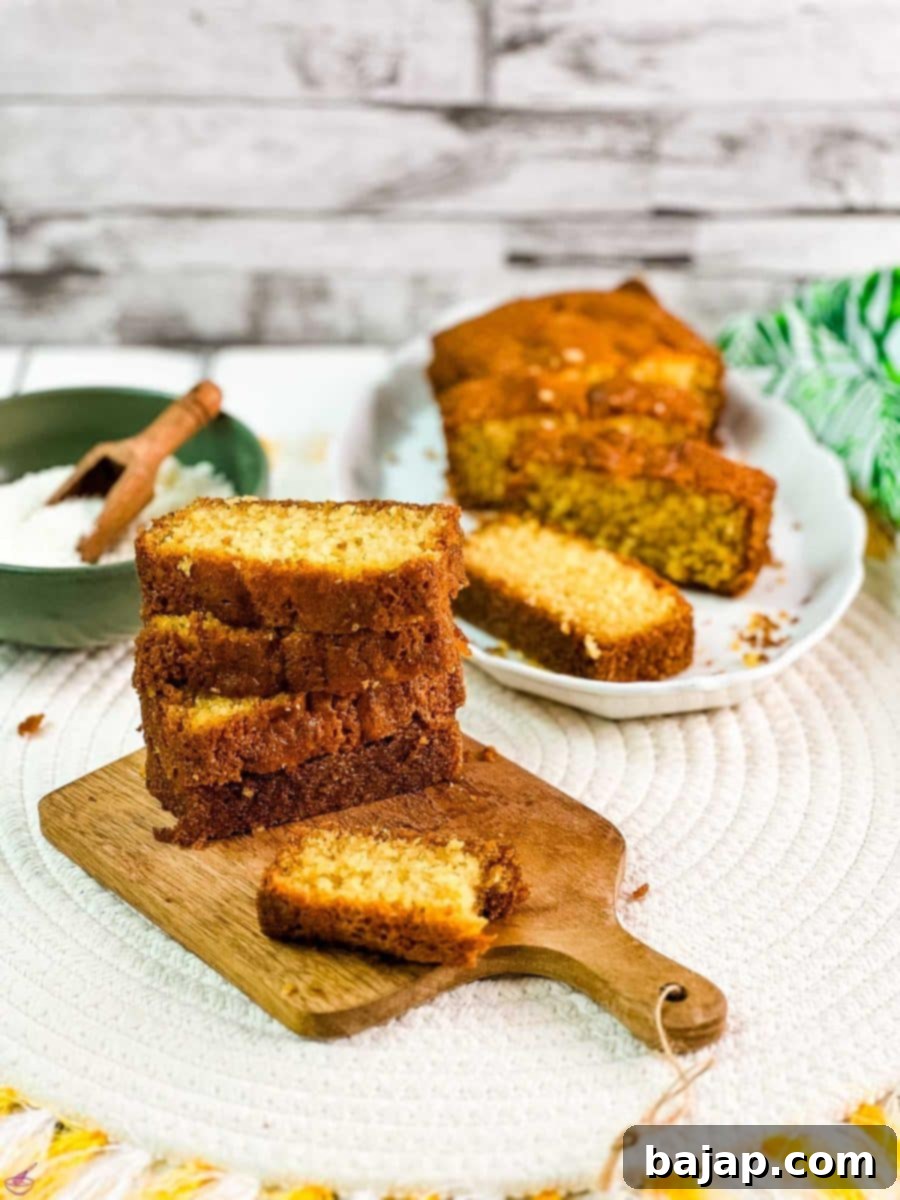
🎯 Expert Tips & Delicious Variations for Your Coconut Pound Cake
Elevate your coconut pound cake with these helpful tips and creative variations:
- Experiment with Dark Rum: While white rum offers a delicate touch, using dark rum will impart a bolder, more caramelized coconut-rum flavor. This is perfect for those who enjoy a richer, more intense taste in their baked goods. Choose a good quality dark rum for the best results.
- Make it Nutty: Add another layer of texture and flavor by incorporating chopped toasted almonds or cashews into the batter. Toasting the nuts beforehand enhances their natural oils and deepens their flavor. They provide a delightful crunch that contrasts beautifully with the cake’s soft crumb.
- Gluten-Free Option: If you’re catering to dietary needs, this recipe can be adapted to be gluten-free. Simply replace the all-purpose flour with a trusted 1:1 gluten-free flour blend. Ensure your chosen blend contains xanthan gum for optimal texture, or add a small amount if it doesn’t.
- Bake Mini Loaves: For charming individual servings or easy gifting, divide the batter into two mini loaf pans. Remember to reduce the baking time significantly – mini loaves typically require around 35 minutes total, but always check for doneness with a skewer. They make adorable party favors or thoughtful hostess gifts.
- Don’t Overmix: After adding the dry ingredients, mix only until just combined. Overmixing can develop the gluten in the flour, resulting in a tough, dense cake rather than the desired light and tender crumb.
- Room Temperature Ingredients: Ensure all cold ingredients, especially butter and eggs, are at room temperature. This helps them emulsify better, creating a smooth, uniform batter that rises more evenly and produces a finer crumb.
- Don’t Peek Too Early: Resist the urge to open the oven door during the first 20-25 minutes of baking. A sudden drop in temperature can cause the cake to collapse.
- Add a Glaze: For an extra touch of sweetness and shine, whisk together powdered sugar with a splash of coconut milk (or rum) and drizzle over the cooled cake.
Other Delicious Recipes for You to Try
- Best Homemade Vanilla Ice Cream Recipe: The perfect pairing for this pound cake, this homemade ice cream is rich and creamy.
- Coconut Chocolate Chip Cookies: If you can’t get enough coconut, these cookies offer a delightful chewy texture with sweet chocolate.
- White Chocolate Coconut Truffles: Indulgent and easy to make, these truffles are a dreamy treat for any coconut lover.
- Austrian Coconut “Busserl” Cookies – Like From Granny: A traditional, heartwarming recipe that brings a taste of authentic Austrian baking.
- How to Make Vanilla Flavored Vodka Whipped Cream: A unique twist on whipped cream, perfect for adventurous palates.
- Easy Vanilla Sauce: A versatile and comforting sauce that pairs well with almost any dessert.
- Divine Leftover Egg Yolk Cookies: Don’t let those extra egg yolks go to waste! These cookies are tender and flavorful.
If you make this scrumptious coconut pound cake recipe, I would absolutely love to hear how you liked it! Please let me know by leaving a ★★★★★ star rating and a comment below. Your feedback means the world to me and helps other bakers too! It would be awesome! You can also sign up for our Newsletter to receive delicious recipes directly in your inbox, or follow me on Pinterest or Instagram and share your creation with me. Just tag me @combinegoodflavors and hashtag #combinegoodflavors, so I don’t miss seeing your beautiful bake!
📖 Recipe Card: Juicy Coconut Pound Cake
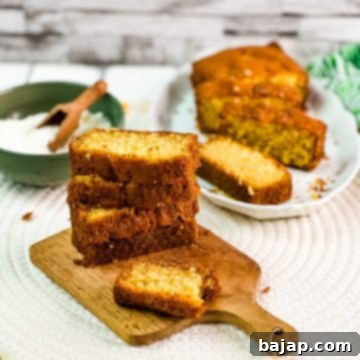
Juicy Coconut Pound Cake
Nora
Save RecipeSaved!
Pin Recipe
Equipment
-
Kitchen machine with a whisk attachment
-
Spatula
-
Loaf Pan 1 big loaf pan or 2 small loaf pans
-
Cooling Rack
Ingredients
- ½ cup Shredded coconut
- 1 ¼ cup Coconut milk can be substituted with regular milk
- 3 tablespoon White rum or coconut milk
- 1 ¼ cup Butter unsalted, at room temperature
- 1 cup Granulated sugar
- 4 Eggs medium-sized
- 1 cup All-purpose flour
- 1 tablespoon Baking powder
- ⅓ tablespoon Baking soda
- ½ teaspoon Kosher salt
- 1 tablespoon Vegetable oil
- Vanilla ice cream optional
Instructions
-
Preheat oven to 350°F (175°C). Grease and line a loaf pan with parchment paper.
-
Mix 1 ¼ cup Coconut milk, 3 tablespoon White rum or coconut milk, and ½ cup Shredded coconut in a small bowl, and then soak for a minimum of 15 minutes.½ cup Shredded coconut, 1 ¼ cup Coconut milk, 3 tablespoon White rum or coconut milk
-
Beat the softened 1 ¼ cup Butter and 1 cup Granulated sugar on high speed using your kitchen machine with a whisk attachment for 3-4 minutes.1 ¼ cup Butter, 1 cup Granulated sugar
-
Lower the speed to medium, and add the 4 Eggs one by one while stopping the mixer and scraping the edges of the bowl between adding each egg.4 Eggs
-
Mix 1 cup All-purpose flour, 1 tablespoon Baking powder, ⅓ tablespoon Baking soda, and ½ teaspoon Kosher salt and sieve them in the butter and egg mix.1 cup All-purpose flour, 1 tablespoon Baking powder, ⅓ tablespoon Baking soda, ½ teaspoon Kosher salt
-
Add the coconut milk mixture and mix 3-4 minutes more.
-
Mix all ingredients together for another 3-4 minutes, starting on medium speed, then increasing it and scraping the edges if needed.
-
Grease the bread pan with 1 tablespoon Vegetable oil and then dust it with flour.1 tablespoon Vegetable oil
-
Pour the dough batter in and bake in a preheated oven at 180 °C // 350 °F for 20 minutes.
-
After the first 20 minutes, score the top of the pound cake with a knife lengthwise; this should help it bake faster and more evenly.
-
Bake for another 25 minutes at the same temperature.
-
After this, poke the pound cake in the middle with a wooden skewer, and when you take it out, it should be dry and have no batter/dough should stick to it.
-
Using a spatula, gently release the sides of the pound cake from the pan and let it let the cake cool down completely, then turn it over.
-
Slice in pieces and serve with Vanilla ice creamVanilla ice cream
Nutrition values are estimates only, using online calculators. Please verify using your own data.

🤎 You Might Also Like These Recipes
- Tropical Coconut Flavored Whipped Cream
- Yummy 40 Yellow-Colored Cocktail and Drink Recipes
- Patriotic Fourth of July No-Bake Cheesecake
- Vanilla Bean Ice Cream Pancakes {Palatschinken}
⛑️ Food Safety Guidelines for Baking
Ensuring food safety is paramount when baking any recipe. Please keep these important guidelines in mind to prevent contamination and ensure a safe and enjoyable culinary experience:
- Cook to a minimum safe temperature: Always ensure your baked goods reach an internal temperature of at least 165°F (74°C) to kill any harmful bacteria. A clean food thermometer is a great tool for this.
- Avoid cross-contamination: Never use the same utensils, cutting boards, or dishes on cooked food that previously touched raw ingredients (especially raw meat or eggs) without thoroughly washing them in hot, soapy water.
- Wash hands frequently: Always wash your hands thoroughly with soap and warm water before handling food, after touching raw ingredients, and after any interruptions like sneezing, coughing, or touching your phone.
- Refrigerate perishable ingredients promptly: Do not leave ingredients like eggs, butter, or milk sitting out at room temperature for extended periods. Return them to the refrigerator as soon as possible after use.
- Never leave cooking food unattended: Stay in the kitchen when baking, especially during critical stages, to prevent over-baking or other mishaps.
- Use oils with high smoking points: If you are greasing pans or adding oil to the batter, choose oils with high smoking points to avoid the formation of harmful compounds when heated.
- Ensure good ventilation: Always ensure your kitchen is well-ventilated when using a gas stove or oven to prevent the buildup of fumes and improve air quality.
For further comprehensive food safety information and best practices, always refer to reputable sources such as the Safe Food Handling guidelines from the FDA.
